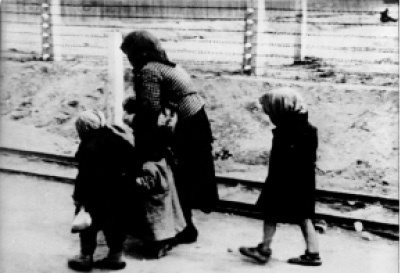Selection
A concentration camp at Auschwitz, in southern Poland, had been operational since 1940 and until early 1942 had predominantly housed Polish political prisoners and Soviet prisoners of war. Thereafter, Auschwitz developed a unique dualism, shared by no other camp in the Nazi system: in addition to being a centre for slave labour, it also became a site of human annihilation. From the summer of 1942, whenever new convoys of Jewish deportees arrived at Auschwitz, there would immediately be a selection to determine which people were fit to work and which would be killed straight away.
The exhausted occupants of the cattle trucks spilled on to the siding at Auschwitz when the train doors opened, disoriented and weak from their journey. Most had little notion of what awaited them, even as SS guards shouted at them to hurry and immediately segregated the men from the women, sometimes using whips to speed up the process. This was the point at which families who had thus far remained together were brutally separated. Once they stood in two columns, a swift appraisal from a high-ranking Nazi doctor would result in a prisoner being sent either to the right or the left of the platform. Women who were pregnant or caring for small children, the elderly and those who appeared frail or sick were all sent in the same direction: to the right. In general, anyone below the age of 16 was automatically placed in this group.
Loudspeakers informed the new arrivals that trucks were waiting to carry anyone who could not walk to the camp. Many gratefully climbed on board, ignoring the whispers from prisoners wearing striped uniforms that they should try to walk no matter how sick they felt. Like the people who had been sent right, the fate of those who were driven into Auschwitz was already sealed. A person who was visibly ill had no value as a slave labourer, nor did a pregnant woman, a child or an older man or woman.

Children and an old woman at Auschwitz, May 1944
Bundesarchiv, Bild 183-74237-004 / CC-BY-SA
Those who had been sent right but could still walk were marched two miles to Birkenau, to where those on the trucks were driven. Here they all sat among the birch woods, for which this part of the vast Auschwitz complex was named, until they were informed that it was their turn to take a shower. Systematically, in large groups, they were pushed into either ‘The Little Red House’ or ‘The Little White House’, cottages that had been deceptively converted into gas chambers. No water flowed from the shower heads of these buildings and within hours of their arrival at Auschwitz, all who had not passed the selection were dead.